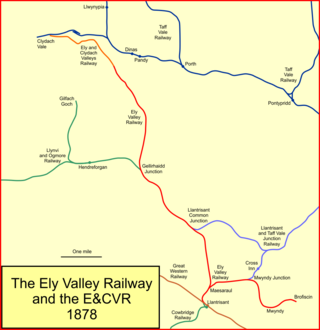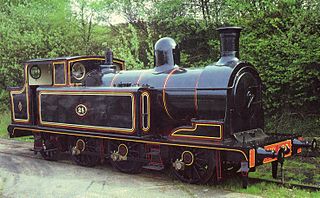
The Taff Vale Railway (TVR) was a standard gauge railway in South Wales, built by the Taff Vale Railway Company to serve the iron and coal industries around Merthyr Tydfil and to connect them with docks in Cardiff. It was opened in stages in 1840 and 1841.

From 1839 the Trustees of the Marquis of Bute, operated a large dock operation in Cardiff, the "Bute Docks". This was very successful, but was overwhelmed by the huge volume of coal exported through Cardiff. At the same time it was seen that railway companies, especially the Taff Vale Railway (TVR), were making money conveying the coal to the docks.
The Rhymney Railway was a railway company in South Wales, founded to transport minerals and materials to and from collieries and ironworks in the Rhymney Valley of South Wales, and to docks in Cardiff. It opened a main line in 1858, and a limited passenger service was operated in addition.

The North British Locomotive Company was created in 1903 through the merger of three Glasgow locomotive manufacturing companies; Sharp, Stewart and Company, Neilson, Reid and Company and Dübs and Company, creating the largest locomotive manufacturing company in Europe and the British Empire.

The Barry Tourist Railway is a railway developed to attract visitors to Barry in the Vale of Glamorgan, South Wales. It is a key element of the Barry Rail Centre which also includes engineering and training facilities.

The GWR 5600 Class is a class of 0-6-2T steam locomotive built between 1924 and 1928. They were designed by Charles Collett for the Great Western Railway (GWR), and were introduced into traffic in 1924. After the 1923 grouping, Swindon inherited a large and variable collection of locomotives from historic Welsh railway companies, which did not fit into their standardisation programme. GWR boiler inspectors arrived en masse and either condemned the original locomotives or had them rebuilt. The systematic destruction of many examples of locomotives, most still in serviceable condition, followed, but various were worked alongside 5600 Class.

Caerphilly railway works in Caerphilly in the county of Glamorgan was the only main railway works in Wales.

The Barry Railway Company was a railway and docks company in South Wales, first incorporated as the Barry Dock and Railway Company in 1884. It arose out of frustration among Rhondda coal owners at congestion and high charges at Cardiff Docks as well the monopoly held by the Taff Vale Railway in transporting coal from the Rhondda. In addition, the Taff Vale did not have the required capacity for the mineral traffic using the route, leading to lengthy delays in getting to Cardiff.
The Pontypridd, Caerphilly and Newport Railway was built to bring the coal output of the Aberdare and Rhondda valleys directly to Alexandra Docks at Newport.

The Rhymney Railway M class was a class of 0-6-2T tank locomotive introduced into traffic on the Rhymney Railway in 1904. These were substantial sized tank engines, and weighed 66 long tons and were 36 feet 9 inches (11.20 m) in length.
The Neath and Brecon Stephensons were 0-6-2T tank locomotives introduced into traffic on the Neath and Brecon Railway in 1904 from a Rhymney Railway design. There were three locos in the class. They were built by Robert Stephenson and Company and were almost identical to the successful Rhymney Railway M class.

Welsh 0-6-2T locomotives were a standard steam locomotive of the railways of South Wales. Many of the independent railways used them and, at the grouping of 1923, the survivors passed into Great Western Railway (GWR) stock. The GWR perpetuated the type in the GWR 5600 Class. The other major railway company in Wales, the LNWR, also had the LNWR Webb Coal Tank Class, though this was grouped into the LMS not the GWR.

The Taff Vale Railway A class was a class of 0-6-2T steam tank locomotives designed by J. Cameron for mixed traffic work and introduced to the Taff Vale Railway (TVR) in 1914. The A class was an enlarged version of the TVR O4 class designed by Tom Hurry Riches in 1907. The A class was the last new class of locomotive to be introduced on the TVR, which had introduced its first 0-6-2Ts in 1885 ; and, with a total of 58 built, was numerically the largest class of tank locomotive on the TVR.

The Taff Vale Railway O4 class was a class of 0-6-2T steam tank locomotives designed by Tom Hurry Riches and introduced to the Taff Vale Railway in 1907. They were rebuilt with taper boilers and superheaters by the Great Western Railway (GWR) from 1924.

Gorton Locomotive Works, known locally as Gorton Tank, was in West Gorton in Manchester, England and was completed in 1848 by the Sheffield, Ashton-under-Lyne and Manchester Railway.

The Ely Valley Railway (EVR) was a broad gauge railway company in South Wales, which opened a mineral line between Llantrisant station on the South Wales Railway main line and pits at Mwyndy and Penrhiwfer in 1860.

The Taff Vale Railway (TVR) O1 class was a class consisting of fourteen 0-6-2T steam tank locomotives, designed by Tom Hurry Riches, which were introduced to the TVR during the period 1894-1897.

Walnut Tree Viaduct was a railway viaduct located above the southern edge of the village of Taffs Well, South Wales. Originally built to carry the Barry Railway across a narrow gorge through which the River Taff, Taff Vale Railway and Cardiff Railway passed, it was deconstructed in 1969, leaving only two of the support columns visible from the A470 road.
Cathays railways works was a railway engineering development by the Taff Vale Railway to provide its main carriage and wagon works, as well as its main railway depot for the entire TVR system, located in the Cathays suburb of Cardiff, South Wales.
Barry Railway Class C were originally 2-4-0T steam locomotives of the Barry Railway in South Wales. They were designed by J. H. Hosgood and built by Sharp Stewart.
















